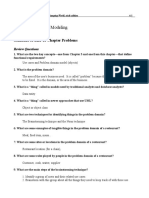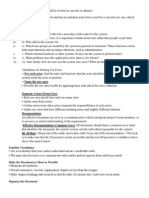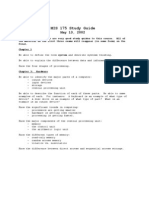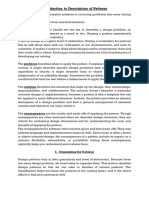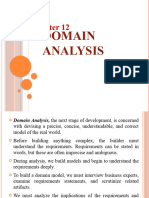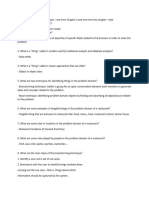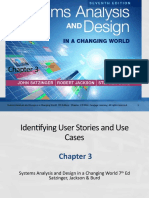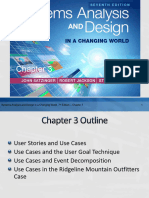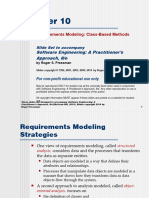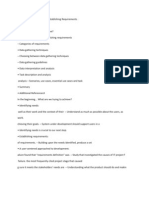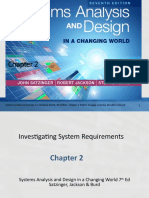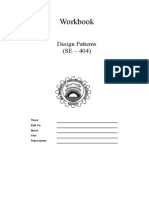SADCW 7e Chapter04
SADCW 7e Chapter04
Uploaded by
Liesbeth NkunaCopyright:
Available Formats
SADCW 7e Chapter04
SADCW 7e Chapter04
Uploaded by
Liesbeth NkunaOriginal Description:
Original Title
Copyright
Available Formats
Share this document
Did you find this document useful?
Is this content inappropriate?
Copyright:
Available Formats
SADCW 7e Chapter04
SADCW 7e Chapter04
Uploaded by
Liesbeth NkunaCopyright:
Available Formats
Chapter 4
Systems Analysis and Design in a Changing World, 7th Edition – Chapter 4 1
©2016. Cengage Learning. All rights reserved.
Domain Modeling
Chapter 4
Systems Analysis and Design in a
Changing World 7th Ed
Satzinger, Jackson & Burd
Systems Analysis and Design in a Changing World, 7th Edition – Chapter 4 2
©2016. Cengage Learning. All rights reserved.
Chapter 4 Outline
“Things” in the Problem Domain
The Entity-Relationship Diagram
The Domain Model Class Diagram
The State Machine Diagram – Identifying Object
Behavior
Systems Analysis and Design in a Changing World, 7th Edition – Chapter 4 3
©2016. Cengage Learning. All rights reserved.
Learning Objectives
Explain how the concept of “things” in the problem domain also
define requirements
Identify and analyze data entities and domain classes needed in
the system
Read, interpret, and create an entity-relationship diagram
Read, interpret, and create a domain model class diagram
Understand the domain model class diagram for the RMO
Consolidated Sales and Marketing System
Read, interpret, and create a state machine diagram that
models object behavior
Systems Analysis and Design in a Changing World, 7th Edition – Chapter 4 4
©2016. Cengage Learning. All rights
reserved.
Overview
This chapter focuses on another key concept for
defining requirements— data entities or domain
classes
In the RMO Tradeshow System from Chapter 1, some
domain classes are Supplier, Product, and Contact
In this chapter’s opening case Waiters on Call,
examples of domain classes are Restaurants, Menu
Items, Customers, Orders, Drivers, Routes, and
Payments
Systems Analysis and Design in a Changing World, 7th Edition – Chapter 4 5
©2016. Cengage Learning. All rights
reserved.
Things in the Problem Domain
Problem domain—the specific area (or domain) of the
users’ business need that is within the scope of the
new system.
“Things” are those items users work with when
accomplishing tasks that need to be remembered
Examples of “Things” are products, sales, shippers,
customers, invoices, payments, etc.
These “Things” are modeled as domain classes or
data entities
In this course, we will call them domain classes. In
database class you may call them data entities
Systems Analysis and Design in a Changing World, 7th Edition – Chapter 4 6
©2016. Cengage Learning. All rights
reserved.
Things in the Problem Domain
Two Techniques for Identifying Them
Brainstorming Technique
Use a checklist of all of the usual types of things
typically found and brainstorm to identify domain
classes of each type
Noun Technique
Identify all of the nouns that come up when the
system is described and determine if each is a
domain class, an attribute, or not something we
need to remember
Systems Analysis and Design in a Changing World, 7th Edition – Chapter 4 7
©2016. Cengage Learning. All rights
reserved.
Brainstorming Technique
Are there any tangible things? Are there any organizational
units? Sites/locations? Are there incidents or events that need
to be recorded?
Systems Analysis and Design in a Changing World, 7th Edition – Chapter 4 8
©2016. Cengage Learning. All rights reserved.
Brainstorming Technique:
Steps
1. Identify a user and a set of use cases
2. Brainstorm with the user to identify things involved when
carrying out the use case—that is, things about which
information should be captured by the system.
3. Use the types of things (categories) to systematically ask
questions about potential things, such as the following: Are
there any tangible things you store information about? Are
there any locations involved? Are there roles played by people
that you need to remember?
4. Continue to work with all types of users and stakeholders to
expand the brainstorming list
5. Merge the results, eliminate any duplicates, and compile an
initial list
Systems Analysis and Design in a Changing World, 7th Edition – Chapter 4 9
©2016. Cengage Learning. All rights reserved.
The Noun Technique
A technique to identify problem domain classes
(things) by finding, classifying, and refining a list of
nouns that come up in in discussions or documents
Popular technique. Systematic.
Does end up with long lists and many nouns that are
not things that need to be stored by the system
Difficulty identifying synonyms and things that are
really attributes
Good place to start when there are no users available
to help brainstorm
Systems Analysis and Design in a Changing World, 7th Edition – Chapter 4 10
©2016. Cengage Learning. All rights reserved.
The Noun Technique:
Steps
1. Using the use cases, actors, and other information about the
system— including inputs and outputs—identify all nouns.
For the RMO CSMS, the nouns might include customer, product item, sale,
confirmation, transaction, shipping, bank, change request, summary report,
management, transaction report, accounting, back order, back order
notification, return, return confirmation…
2. Using other information from existing systems, current
procedures, and current reports or forms, add items or
categories of information needed.
For the RMO CSMS, these might include price, size, color, style, season,
inventory quantity, payment method, and shipping address.
Systems Analysis and Design in a Changing World, 7th Edition – Chapter 4 11
©2016. Cengage Learning. All rights reserved.
The Noun Technique:
Steps (continued)
3. As this list of nouns builds, refine it. Ask these questions about
each noun to help you decide whether you should include it:
Is it a unique thing the system needs to know about?
Is it inside the scope of the system I am working on?
Does the system need to remember more than one of these items?
Ask these questions to decide to exclude it:
Is it really a synonym for some other thing I have identified?
Is it really just an output of the system produced from other information I have
identified?
Is it really just an input that results in recording some other information I have
identified?
Ask these questions to research it:
Is it likely to be a specific piece of information (attribute) about some other
thing I have identified?
Is it something I might need if assumptions change?
Systems Analysis and Design in a Changing World, 7th Edition – Chapter 4 12
©2016. Cengage Learning. All rights reserved.
The Noun Technique:
Steps (continued)
4. Create a master list of all nouns identified and then note
whether each one should be included, excluded, or researched
further.
5. Review the list with users, stakeholders, and team members
and then define the list of things in the problem domain.
Systems Analysis and Design in a Changing World, 7th Edition – Chapter 4 13
©2016. Cengage Learning. All rights reserved.
Partial List of Nouns for RMO
With notes on
whether to include
as domain class
Systems Analysis and Design in a Changing World, 7th Edition – Chapter 4 14
©2016. Cengage Learning. All rights reserved.
Details about Domain Classes
Attribute— describes one piece of information about
each instance of the class
Customer has first name, last name, phone number
Identifier or key
One attribute uniquely identifies an instance of the class.
Required for data entities, optional for domain classes.
Customer ID identifies a customer
Compound attribute
Two or more attributes combined into one structure to
simplify the model. (E.g., address rather than including
number, street, city, state, zip separately). Sometimes an
identifier or key is a compound attribute.
Systems Analysis and Design in a Changing World, 7th Edition – Chapter 4 15
©2016. Cengage Learning. All rights reserved.
Attributes and Values
Class is a type of thing. Object is a specific instance of the class.
Each instance has its own values for an attribute
Systems Analysis and Design in a Changing World, 7th Edition – Chapter 4 16
©2016. Cengage Learning. All rights reserved.
Associations Among Things
Association— a naturally occurring
relationship between classes (UML term)
Systems Analysis and Design in a Changing World, 7th Edition – Chapter 4 17
©2016. Cengage Learning. All rights reserved.
Just to Clarify…
Called association on class diagram in UML
Multiplicity is term for the number of associations between classes: 1 to
1 or 1 to many (synonym to cardinality)
UML is the primary emphasis of this text
Called relationship on ERD in database class
Cardinality is term for number of relationships in entity relationship
diagrams: 1 to 1 or 1 to many (synonym to multiplicity)
Associations and Relationships apply in two directions
Read them separately each way
A customer places an order
An order is placed by a customer
Systems Analysis and Design in a Changing World, 7th Edition – Chapter 4 18
©2016. Cengage Learning. All rights reserved.
Minimum and Maximum Multiplicity
Associations have minimum and maximum constraints
minimum is zero, the association is optional
If minimum is at least one, the association is mandatory
Systems Analysis and Design in a Changing World, 7th Edition – Chapter 4 19
©2016. Cengage Learning. All rights reserved.
Types of Associations
Binary Association
Associations between exactly two different classes
Course Section includes Students
Members join Club
Unary Association (recursive)
Associations between two instances of the same
class
Person married to person
Part is made using parts
Ternary Association (three)
N-ary Association (between n)
Systems Analysis and Design in a Changing World, 7th Edition – Chapter 4 20
©2016. Cengage Learning. All rights reserved.
Entity-Relationship Diagrams
ERD
ERDs have been used for many years to develop data
models that are used in database development
The term for “things” in ERD models is data entities
ERD models are not UML models and do not use
standard UML notation
ERD models are not as expressive as UML models
They do not model generalization/specialization well
They do not model whole/part well
Systems Analysis and Design in a Changing World, 7th Edition – Chapter 4 21
©2016. Cengage Learning. All rights reserved.
Example of ERD Notation
ERD Models normally use “crows feet” notation
to show cardinality
Systems Analysis and Design in a Changing World, 7th Edition – Chapter 4 22
©2016. Cengage Learning. All rights reserved.
ERD Cardinality Symbols
Examples of crows feet notation for various
cardinalities
Systems Analysis and Design in a Changing World, 7th Edition – Chapter 4 23
©2016. Cengage Learning. All rights reserved.
Expanded ERD with Attributes
ERD with cardinalities and attributes
There are several different notation methods for
attributes in ERD models
This notation places attributes within data entities
Systems Analysis and Design in a Changing World, 7th Edition – Chapter 4 24
©2016. Cengage Learning. All rights reserved.
Semantic Net
A semantic net is a graphical representation of
an individual data entity and its relationship
with other individual entities
It is often used to help understand and then
develop an ERD model
Systems Analysis and Design in a Changing World, 7th Edition – Chapter 4 25
©2016. Cengage Learning. All rights reserved.
Semantic Net
This example shows
three classes.
Quick quiz
What are the classes?
How many relationships?
What are min and max
cardinalities?
What type of
relationships are they?
Systems Analysis and Design in a Changing World, 7th Edition – Chapter 4 26
©2016. Cengage Learning. All rights reserved.
An ERD for a Bank
Quick Quiz
What are the key
fields?
How many
accounts can a
customer have?
How many
branches can a
customer be
assigned to?
How many
customers can a
branch have?
Systems Analysis and Design in a Changing World, 7th Edition – Chapter 4 27
©2016. Cengage Learning. All rights reserved.
The Domain Model Class Diagram
Class
A type of classification used to describe a collection of objects
Domain Class
Classes that describe objects in the problem domain
Class Diagram
A UML diagram that shows classes with attributes and
associations (plus methods if it models software classes)
Domain Model Class Diagram
A class diagram that only includes classes from the problem
domain, not software classes so no methods
Systems Analysis and Design in a Changing World, 7th Edition – Chapter 4 28
©2016. Cengage Learning. All rights reserved.
UML Domain Class Notation
Domain class a name and attributes (no methods)
Class name is always capitalized
Attribute names are not capitalized and use camelback
notation (words run together and second word is
capitalized)
Compound class names also use camelback notation
Systems Analysis and Design in a Changing World, 7th Edition – Chapter 4 29
©2016. Cengage Learning. All rights reserved.
A Simple Domain Model Class Diagram
Note: This diagram matches the semantic net shown
previously
A customer places zero or more orders
An order is placed by exactly one customer
An order consists of one or more order items
An order item is part of exactly one order
Systems Analysis and Design in a Changing World, 7th Edition – Chapter 4 30
©2016. Cengage Learning. All rights reserved.
UML Notation for Multiplicity
Systems Analysis and Design in a Changing World, 7th Edition – Chapter 4 31
©2016. Cengage Learning. All rights
reserved.
Domain Model Class Diagram
Bank with many branches as show previously in ERD
Note notation for the key
Note the precise notation for the attributes (camelback)
Note the multiplicity notation
Systems Analysis and Design in a Changing World, 7th Edition – Chapter 4 32
©2016. Cengage Learning. All rights reserved.
Domain Model Class Diagram
Course Enrollment at a
University
A Course has many
CourseSections
A CourseSection has
many Students and a
Student is registered in
many CourseSections
Problem
How/where to capture
student grades?
Systems Analysis and Design in a Changing World, 7th Edition – Chapter 4 33
©2016. Cengage Learning. All rights reserved.
Refined Course Enrollment Model
with an Association Class CourseEnrollment
Association class— an association that is treated as a
class in a many to many association because it has
attributes that need to be remembered (such as grade)
Systems Analysis and Design in a Changing World, 7th Edition – Chapter 4 34
©2016. Cengage Learning. All rights reserved.
Association Class Properties
The association class is the same “thing” as the
association itself
The unique identifier (key) for the association class is
the concatenation of the keys of the attached classes
In the previous example the key for CourseSection is
CourseNumber+SectionNumber
Hence the key for CourseEnrollment is
CourseNumber+SectionNumber+StudentID
Note: If more information is required to uniquely identify
instances of the association class, then the model is
incorrect, i.e., if the key cannot be formed by the
concatenation of the endpoint keys, it is in error.
Systems Analysis and Design in a Changing World, 7th Edition – Chapter 4 35
©2016. Cengage Learning. All rights reserved.
Band with members and concerts
Quick Quiz
How many bands can a
person play in?
For a band, how many
concerts can it play in?
For a concert, how many
bands may be playing?
What attributes can you
use for keys? Do you
need to add “key”
attributes?
Systems Analysis and Design in a Changing World, 7th Edition – Chapter 4 36
©2016. Cengage Learning. All rights reserved.
Band with Concert Booking Information
Note: The association class (Booking) also provides a name and
meaning for the association
Given the keys you identified, what is the key for the Booking
class? Does it uniquely identify instances?
Systems Analysis and Design in a Changing World, 7th Edition – Chapter 4 37
©2016. Cengage Learning. All rights reserved.
More Complex Issues about Classes:
Generalization/Specialization Relationships
Generalization/Specialization
A hierarchical relationship where subordinate classes are special types
of the superior classes. Often called an Inheritance Hierarchy
Superclass
the superior or more general class in a generalization/specialization
hierarchy
Subclass
the subordinate or more specialized class in a
generalization/specialization hierarchy
Inheritance
the concept that subclasses classes inherit characteristics of the more
general superclass
Systems Analysis and Design in a Changing World, 7th Edition – Chapter 4 38
©2016. Cengage Learning. All rights reserved.
Generalization/Specialization
Systems Analysis and Design in a Changing World, 7th Edition – Chapter 4 39
©2016. Cengage Learning. All rights
reserved.
Generalization/Specialization
Inheritance for RMO Three Types of Sales
Abstract class— a class that allow subclasses to inherit
characteristics but never gets instantiated. In Italics (Sale)
Concrete class— a class that can have instances
Inheritance – Attributes of OnlineSale are:
timeOnSite, chatUse, saleDateTime, priorityCode, S&H, tax, totalAmt…
Systems Analysis and Design in a Changing World, 7th Edition – Chapter 4 40
©2016. Cengage Learning. All rights reserved.
Generalization/Specialization
Inheritance for the Bank with Special Types of Accounts
A SavingsAccount has
4 attributes
A CheckingAccount
has 5 attributes
Note: the subclasses
inherit the
associations too
Systems Analysis and Design in a Changing World, 7th Edition – Chapter 4 41
©2016. Cengage Learning. All rights reserved.
More Complex Issues about Classes:
Whole Part Relationships
Whole-part relationship— a relationship between classes where
one class is part of or a component portion of another class
Aggregation— a whole part relationship where the component
part exists separately and can be removed and replaced (UML
diamond symbol on next slide)
Computer has disk storage devices (storage devices exist apart from
computer)
Car has wheels (wheels can be removed and still be wheels)
Composition— a whole part relationship where the parts cannot
be removed (filled in diamond symbol)
OrderItem on an Order (without the Order, there are no OrderIterms)
Chip has circuits (without the chip, there are no circuits)
Systems Analysis and Design in a Changing World, 7th Edition – Chapter 4 42
©2016. Cengage Learning. All rights reserved.
Whole Part Relationships
Computer and its Parts
Note: this is composition,
with diamond symbol.
Whole part can have
multiplicity symbols, too
(not shown)
Systems Analysis and Design in a Changing World, 7th Edition – Chapter 4 43
©2016. Cengage Learning. All rights
reserved.
More on UML Relationships
There are actually three types of relationships in
class diagrams
Association Relationships
These are associations discussed previously, just like ERD
relationships
Whole Part Relationships
One class is a component or part of another class
Generalizations/Specialization Relationships
Inheritance
Try not to confuse relationship with association
Systems Analysis and Design in a Changing World, 7th Edition – Chapter 4 44
©2016. Cengage Learning. All rights reserved.
RMO CSMS Project
Domain Model Class Diagrams
There are several ways to create the domain model
class diagram for a project
RMO CSMS has 27 domain classes overall
Can create one domain model class diagram per
subsystem for those working on a subsystem
Can create one overall domain model class diagram to
provide an overview of the whole system
Usually in early iterations, an initial draft of the domain
model class diagram is completed and kept up to date.
It is used to guide development.
Systems Analysis and Design in a Changing World, 7th Edition – Chapter 4 45
©2016. Cengage Learning. All rights reserved.
RMO CSMS Project
Sales Subsystem Domain
Model Class Diagrams
Systems Analysis and Design in a Changing World, 7th Edition – Chapter 4 46
©2016. Cengage Learning. All rights
reserved.
RMO CSMS Project
Customer Account Subsystem
Domain Model Class Diagram
Systems Analysis and Design in a Changing World, 7th Edition – Chapter 4 47
©2016. Cengage Learning. All rights
reserved.
RMO CSMS Project
Complete Domain Model Class
Diagram
Systems Analysis and Design in a Changing World, 7th Edition – Chapter 4 48
©2016. Cengage Learning. All rights
reserved.
RMO CSMS Project
Domain Model Class Diagrams
Given the complete RMO CSMS Domain Model Class Diagram
and Sales and Customer Account subsystem examples:
Try completing the Order Fulfilment Subsystem Domain Model Class
Diagram
Try Completing the Marketing Subsystem Domain Model Class Diagram
Try Completing the Reporting Subsystem Domain Model Class Diagram
Review the use cases from Chapter 3 and decide what classes
and associations from the complete model are required for each
subsystem
Classes and associations might be duplicated in more than one
subsystem model
Systems Analysis and Design in a Changing World, 7th Edition – Chapter 4 49
©2016. Cengage Learning. All rights reserved.
Object Behavior –
State Machine Diagram
Each class has objects that may have status
conditions or “states”
Object behavior consists of the various states
and the movement between these states
State – a condition during an object’s life when
it satisfies some criterion, performs an action,
or waits for an event
Transition – the movement of an object from
one state to another
Systems Analysis and Design in a Changing World, 7th Edition – Chapter 4 50
©2016. Cengage Learning. All rights reserved.
State Machine Diagram
State Machine Diagram – a diagram which shows the life of an
object in states and transitions
Origin state – the original state of an object before it begins a
transition
Destination state – the state to which an object moves after
completing a transition
pseudostate – the starting point in a state machine diagram.
Noted by a black circle.
action-expression – some activity that must be completed as
part of a transition
guard-condition – a true/false test to see whether a transition
can fire
Systems Analysis and Design in a Changing World, 7th Edition – Chapter 4 51
©2016. Cengage Learning. All rights reserved.
State Machine for a Printer
Syntax of transition statement
transition-name (parameters, …) [guard-condition] / action-expression
Systems Analysis and Design in a Changing World, 7th Edition – Chapter 4 52
©2016. Cengage Learning. All rights reserved.
Concurrency in a State Machine Diagram
Concurrent states – when an object is in one or
more states at the same time
Path – a sequential set of connected states and
transitions
Concurrent paths – when multiple paths are
being followed concurrently, i.e. when one or
more states in one path are parallel to states in
another path
Systems Analysis and Design in a Changing World, 7th Edition – Chapter 4 53
©2016. Cengage Learning. All rights reserved.
Printer with Concurrent Paths
Concurrent paths often shown by synchronization bars (same as
Activity Diagram)
Multiple exits from a state is an “OR” condition.
Multiple exits from a synchronization bar is an “AND” condition.
Systems Analysis and Design in a Changing World, 7th Edition – Chapter 4 54
©2016. Cengage Learning. All rights reserved.
Creating a State Machine Diagram
Steps
1. Review the class diagram and select classes that might require
state machine diagrams
2. For each class, make a list of status conditions (states) you can
identify
3. Begin building diagram fragments by identifying transitions that
cause an object to leave the identified state
4. Sequence these states in the correct order and aggregate
combinations into larger fragments
5. Review paths and look for independent, concurrent paths
Systems Analysis and Design in a Changing World, 7th Edition – Chapter 4 55
©2016. Cengage Learning. All rights reserved.
Creating a State Machine Diagram
Steps (continued)
6. Look for additional transitions and test both directions
7. Expand each transition with appropriate message event, guard
condition, and action expression
8. Review and test the state machine diagram for the class
Make sure state are really state for the object in the class
Follow the life cycle of an object coming into existence and being deleted
Be sure the diagram covers all exception condition
Look again for concurrent paths and composite states
Systems Analysis and Design in a Changing World, 7th Edition – Chapter 4 56
©2016. Cengage Learning. All rights reserved.
RMO – Creating a State Machine Diagram
Steps -- SaleItem
1. Choose SaleItem. It has status conditions that need to be
tracked
2. List the states and exit transitions
Systems Analysis and Design in a Changing World, 7th Edition – Chapter 4 57
©2016. Cengage Learning. All rights reserved.
RMO – Creating a State Machine Diagram
Steps -- SaleItem
3. Build fragments – see figure below
4. Sequence in correct order – see figure below
5. Look for concurrent paths – none
Systems Analysis and Design in a Changing World, 7th Edition – Chapter 4 58
©2016. Cengage Learning. All rights reserved.
RMO – Creating a State Machine Diagram
Steps -- SaleItem
6. Add other required transitions
7. Expand with guard, action-expressions etc.
8. Review and test
Below is the final State Machine Diagram
Systems Analysis and Design in a Changing World, 7th Edition – Chapter 4 59
©2016. Cengage Learning. All rights reserved.
RMO – Creating a State Machine Diagram
Steps -- InventoryItem
1. Choose InventoryItem. It has status conditions that need to be
tracked
2. List the states and exit transitions
Systems Analysis and Design in a Changing World, 7th Edition – Chapter 4 60
©2016. Cengage Learning. All rights reserved.
RMO – Creating a State Machine Diagram
Steps -- InventoryItem
3. Build fragments – see figure below
4. Sequence in correct order – see figure below
5. Look for concurrent paths – see figure below
Systems Analysis and Design in a Changing World, 7th Edition – Chapter 4 61
©2016. Cengage Learning. All rights reserved.
RMO – Creating a State Machine Diagram
Steps -- InventoryItem
6. Add other required transitions
7. Expand with guard, action-expressions etc.
8. Review and test
Below is the final State Machine Diagram
Systems Analysis and Design in a Changing World, 7th Edition – Chapter 4 62
©2016. Cengage Learning. All rights reserved.
Summary
This chapter focuses on modeling functional
requirements as a part of systems analysis
“Things” in the problem domain are identified and
modeled, called domain classes or data entities
Two techniques for identifying domain classes/data
entities are the brainstorming technique and the noun
technique
Domain classes have attributes and associations
Associations are naturally occurring relationships
among classes, and associations have minimum and
maximum multiplicity
Systems Analysis and Design in a Changing World, 7th Edition – Chapter 4 63
©2016. Cengage Learning. All rights reserved.
Summary
Entity-relationship diagrams (ERDs) show the
information about data entities
ERDs are often preferred by database analysts and are
widely used
ERDs are not UML diagrams, and an association is
called a relationship, multiplicity is called cardinality,
and generalization/specialization (inheritance) and
whole part relationships are usually not shown
Systems Analysis and Design in a Changing World, 7th Edition – Chapter 4 64
©2016. Cengage Learning. All rights
reserved.
Summary
The UML class diagram notation is used to create a
domain model class diagram for a system. The domain
model classes do not have methods because they are
not yet software classes.
There are actually three UML class diagram
relationships: association relationships,
generalization/specialization (inheritance)
relationships, and whole part relationships
Other class diagram concepts are abstract versus
concrete classes, compound attributes, composition
and aggregation, association classes, super classes
and subclasses
Systems Analysis and Design in a Changing World, 7th Edition – Chapter 4 65
©2016. Cengage Learning. All rights
reserved.
Summary
Some objects have a life cycle with status
conditions that change and should be tracked
A State Machine Diagram tracks the behavior of
these objects with states and transitions
To develop a State Machine Diagram
Choose a single object class.
Identify the states and exit transitions
Identify concurrent paths
Identify additional paths
Build the State Machine Diagram
Systems Analysis and Design in a Changing World, 7th Edition – Chapter 4 66
©2016. Cengage Learning. All rights reserved.
Summary
Draw an entity-relationship diagram, including
minimum and maximum cardinality, for the
following: The system stores information about
two things: cars and owners. A car has
attributes for make, model, and year. The
owner has attributes for name and address.
Assume that a car must be owned by one
owner and an owner can own many cars, but
an owner might not own any cars (perhaps she
just sold them all, but you still want a record of
her in the system).
Systems Analysis and Design in a Changing World, 7th Edition – Chapter 4 67
©2016. Cengage Learning. All rights reserved.
Summary
Draw a class diagram for the cars and owners
described in exercise 1, but include subclasses
for sports car, sedan, and minivan, with
appropriate attributes.
Systems Analysis and Design in a Changing World, 7th Edition – Chapter 4 68
©2016. Cengage Learning. All rights reserved.
Summary
Draw a class diagram for the cars and owners
described in exercise 1, but include subclasses
for sports car, sedan, and minivan, with
appropriate attributes.
Systems Analysis and Design in a Changing World, 7th Edition – Chapter 4 69
©2016. Cengage Learning. All rights reserved.
You might also like
- Computer Storage Fundamentals: Storage system, storage networking and host connectivityFrom EverandComputer Storage Fundamentals: Storage system, storage networking and host connectivityNo ratings yet
- Introduction To Systems Analysis and Design:: An Agile, Iterative ApproachDocument49 pagesIntroduction To Systems Analysis and Design:: An Agile, Iterative ApproachAmalNo ratings yet
- Pega Interview FinalDocument26 pagesPega Interview FinalSucharitha RametiNo ratings yet
- Basics: Architecture, Guardials, Inheritance, Methodology, Classes 6'RsDocument27 pagesBasics: Architecture, Guardials, Inheritance, Methodology, Classes 6'RsKishore Velakaturi100% (1)
- A2 HadiDocument5 pagesA2 HadiHadi AssaadNo ratings yet
- Systems Analysis and Design in A Changing World, 7th Edition - Chapter 4 ©2016. Cengage Learning. All Rights Reserved. 1Document67 pagesSystems Analysis and Design in A Changing World, 7th Edition - Chapter 4 ©2016. Cengage Learning. All Rights Reserved. 1CarlosNo ratings yet
- Chapter4 - Domain ClassesDocument49 pagesChapter4 - Domain Classesameerayman38No ratings yet
- Systems Analysis and Design Agile Iterative Approach Chapter 4Document49 pagesSystems Analysis and Design Agile Iterative Approach Chapter 4ulbrichNo ratings yet
- 6ed Solutions Chap04Document21 pages6ed Solutions Chap04JesseSpero60% (5)
- 1 Systems Analysis and Design in A Changing World, 7th Edition - Chapter 3 ©2016. Cengage Learning. All Rights ReservedDocument37 pages1 Systems Analysis and Design in A Changing World, 7th Edition - Chapter 3 ©2016. Cengage Learning. All Rights ReservedCarlosNo ratings yet
- Reverse A StringDocument4 pagesReverse A Stringvjvi2002No ratings yet
- Systems Analysis and Design in A Changing World, 7 Edition - Chapter 3 1Document44 pagesSystems Analysis and Design in A Changing World, 7 Edition - Chapter 3 1NatalieNo ratings yet
- Separate Actors From Users: Familiar VocabularyDocument9 pagesSeparate Actors From Users: Familiar Vocabularyshilpareddy888No ratings yet
- CSIT114-Week 6 - Domain ModellingDocument49 pagesCSIT114-Week 6 - Domain Modellingadam hopeNo ratings yet
- SADCW 7e Chapter03Document37 pagesSADCW 7e Chapter03Liesbeth NkunaNo ratings yet
- CS1310 Ooad 3 PDFDocument18 pagesCS1310 Ooad 3 PDFbaladivya15No ratings yet
- MIS 175 Study GuideDocument7 pagesMIS 175 Study GuideZeeshan KhanNo ratings yet
- SADP Unit 3Document18 pagesSADP Unit 3Dept of MCA SIETNo ratings yet
- OoadDocument5 pagesOoadPrabhu DhandapaniNo ratings yet
- Chapter 3Document37 pagesChapter 3hitlarwwNo ratings yet
- Sepm QB AnswersDocument11 pagesSepm QB AnswersamplifydocumentNo ratings yet
- Chapter 12-Domain AnalysisDocument79 pagesChapter 12-Domain Analysiskshitijsriram2683No ratings yet
- Modern Systems Analysis and Design 7th Edition Hoffer Solutions Manual DownloadDocument10 pagesModern Systems Analysis and Design 7th Edition Hoffer Solutions Manual DownloadDeborah Williams100% (25)
- Rad 2Document6 pagesRad 2phongth779No ratings yet
- Unit 2 Notes - OoadDocument81 pagesUnit 2 Notes - OoadMALARMANNAN ANo ratings yet
- Chapter Six Gathering User RequirementsDocument17 pagesChapter Six Gathering User RequirementsHamba Abebe100% (1)
- UseCases - Ch3 Updated Nov 2020v2Document46 pagesUseCases - Ch3 Updated Nov 2020v2Afaf Al-HasawiNo ratings yet
- 6ed Solutions Chap11Document52 pages6ed Solutions Chap11JesseSpero100% (3)
- Chapter 2Document44 pagesChapter 2amjadosa.2000No ratings yet
- 1 Text Mining Review SlidesDocument78 pages1 Text Mining Review SlidesWalid_Sassi_TunNo ratings yet
- Concern-Oriented: AND Analysis of Information SystemsDocument21 pagesConcern-Oriented: AND Analysis of Information Systemscrenguta_bogdan4677No ratings yet
- Chapter 4 RevisonDocument15 pagesChapter 4 Revisontaariqc2000No ratings yet
- Dwnload Full Systems Analysis and Design in A Changing World 7th Edition Satzinger Solutions Manual PDFDocument36 pagesDwnload Full Systems Analysis and Design in A Changing World 7th Edition Satzinger Solutions Manual PDFsurfaceaunterbdkid100% (20)
- Class Diagram IntroDocument68 pagesClass Diagram Intronoluthandombeje0No ratings yet
- 340week 1 GuidanceDocument10 pages340week 1 Guidancenamgay tenzinNo ratings yet
- Chapter 3Document38 pagesChapter 3amjadosa.2000No ratings yet
- Unit Ii Ooad NotesDocument12 pagesUnit Ii Ooad Notess.ranjithNo ratings yet
- The CRC CardDocument2 pagesThe CRC Card021 Kaviya PNo ratings yet
- OOAD 2 MARKS FINALDocument27 pagesOOAD 2 MARKS FINALshyniNo ratings yet
- SAD10e Ch06 Solutions To ExercisesDocument42 pagesSAD10e Ch06 Solutions To ExercisesashimiumohammedkamilNo ratings yet
- Chapter 02 LectureDocument12 pagesChapter 02 LectureLiesbeth NkunaNo ratings yet
- System Analysis and Design Module 2Document17 pagesSystem Analysis and Design Module 2Neivil Jean N. EgoniaNo ratings yet
- Oosad CH2Document8 pagesOosad CH2Malicha GalmaNo ratings yet
- 10 - Requirements Modeling ClassBased MethodsDocument19 pages10 - Requirements Modeling ClassBased MethodsShafa-at AliNo ratings yet
- Investigating System Requirements: Systems Analysis and Design in A Changing World 6 Ed Satzinger, Jackson & BurdDocument55 pagesInvestigating System Requirements: Systems Analysis and Design in A Changing World 6 Ed Satzinger, Jackson & BurdRussel LimNo ratings yet
- Identifying User Needs and Establishing RequirementsDocument13 pagesIdentifying User Needs and Establishing RequirementsNeenisha FawazNo ratings yet
- Systems Analysis and Design in A Changing World, 7th Edition - Chapter 2 ©2016. Cengage Learning. All Rights Reserved. 1Document43 pagesSystems Analysis and Design in A Changing World, 7th Edition - Chapter 2 ©2016. Cengage Learning. All Rights Reserved. 1CarlosNo ratings yet
- Requirement GatheringDocument11 pagesRequirement GatheringHira FarooqNo ratings yet
- Chapter 5 - Understanding RequirementsDocument6 pagesChapter 5 - Understanding RequirementsDanish PawaskarNo ratings yet
- BA QuestionsDocument45 pagesBA QuestionsRoksanaNo ratings yet
- Se M3 CombineDocument35 pagesSe M3 CombineAnjali AnishNo ratings yet
- Design PatternsDocument24 pagesDesign PatternsShayan SikandarNo ratings yet
- Class Xii Model Life CycleDocument6 pagesClass Xii Model Life Cyclebabusahab24680qwertyNo ratings yet
- Ooad U1 KeyDocument57 pagesOoad U1 KeyWAR THANESHNo ratings yet
- Chapter 1: Introduction To Decision Support SystemsDocument6 pagesChapter 1: Introduction To Decision Support Systemss2rc29No ratings yet
- System Analysis Design Thesis FormatDocument4 pagesSystem Analysis Design Thesis FormatHelpPaperRochester100% (2)
- Lecture 4Document37 pagesLecture 4weetan studioNo ratings yet
- Systems For DecisionDocument27 pagesSystems For Decisionsocimedia300No ratings yet
- Unit - 1 QB AnswersDocument15 pagesUnit - 1 QB Answers20CSE312 BHANU PRAKASHNo ratings yet
- Hands-On Data Preprocessing in Python: Learn how to effectively prepare data for successful data analyticsFrom EverandHands-On Data Preprocessing in Python: Learn how to effectively prepare data for successful data analyticsNo ratings yet








